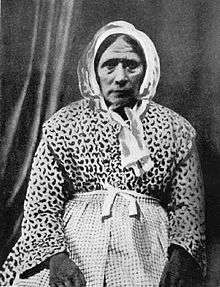Kitty Wilkinson

Kitty Wilkinson (Catherine Wilkinson) (1786–1860)[2][3] was an Irish migrant, "wife of a labourer", who became known as the Saint of the Slums.[2] In 1832, during a cholera epidemic, she had the only boiler in her neighbourhood, so she invited those with infected clothes or linens to use it, thus saving many lives. This was the first public washhouse in Liverpool. Ten years later with public funds her efforts resulted in the opening of a combined washhouse and public baths, the first in the United Kingdom.
Personal life
Wilkinson was born Catherine Seaward in County Londonderry, Ireland, and at the age of nine was coming to Liverpool with her parents, when their ship ran aground in the Mersey and her father and younger sister drowned. At twelve years of age she went to work at a cotton mill in Caton, Lancashire, where she was an indentured apprentice. At age 20 she left the mill and returned to live with her mother in Liverpool, where they both were in domestic service. Shortly thereafter she married a sailor, Emanuel Demontee, although her mother continued to live with her. After two children in quick succession,[4] with her husband drowned at sea, she returned to domestic service. But shortly thereafter, upon being gifted with a mangle, she set herself up as a laundress. In 1823, she married Tom Wilkinson, a warehouse porter, and they continued to live at the Denison Street house that she rented.
Crusade
In 1832, cholera broke out in Liverpool. Wilkinson took the initiative to offer the use of her boiler, house and yard to neighbours to wash their clothes, at a charge of 1 penny per week,[5] and she showed them how to use a chloride of lime to get them clean. Boiling killed the cholera bacteria. Once these activities came to their attention, Wilkinson was supported by the District Provident Society and William Rathbone. Convinced of the importance of cleanliness in combating disease, she pushed for the establishment of public baths where the poor could bathe. In 1842 the combined public baths and washhouse was opened on Upper Fredrick Street in Liverpool, and in 1846 Wilkinson was appointed superintendent of the public baths.[1][6]
In 1846 the Mayoress presented Wilkinson with a silver teapot from Queen Victoria en-scribed "The Queen, the Queen Dowager, and the Ladies of Liverpool to Catherine Wilkinson, 1846."[7] Wilkinson died in Liverpool and was buried in the St. James Cemetery.[3] with the inscription:
CATHERINE WILKINSON. Died 11 November 1860, aged 73. Indefatigable and self-denying She was the Widow's friend. The support of the Orphan. The fearless and unwearied nurse of the sick. The originator of Baths and Wash-houses for the poor. 'For all they did cast in of their abundance; but she of her want did cast in all that she had, even all her living.' St. Mark, 12th Chapter, 44th Verse.
In 2012, a marble statue of Kitty Wilkinson was unveiled in St George's Hall.[8]
Biographies
In 1910 The Life of Kitty Wilkinson was published by Winifred Rathbone which provided a more accurate story of her life than previously available in Catherine of Liverpool in Chambers' Miscellany, Vol III.[9]
In 2000, the first official contemporary account of Kitty Wilkinson's biography was written by Liverpool author and civic historian Michael Kelly, in his book The Life of Kitty Wilkinson. Kelly also starred in a short documentary about Wilkinson's life, produced by a group of students at Edge Hill University in 2014, with the title Kitty: The Saint of the Slums.
See also
Notes
- 1 2 Rathbone, Herbert R. (1927), Memoir of Kitty Wilkinson of Liverpool, 1786-1860: with a short account of Thomas Wilkinson, her husband, H. Young & Sons
- 1 2 "'Slum Saint' honoured with statue". BBC News. 4 February 2010.
- 1 2 http://www.stjamescemetery.co.uk/kitty.htm
- ↑ Her second child was born after her husband's death.
- ↑ Ashpitel 1851, pp. 2–14
- ↑ Wohl, Anthony S. (1984), Endangered lives: public health in Victorian Britain, Taylor & Francis, p. 73, ISBN 978-0-416-37950-1
- ↑ (Rathbone 1927), a plate showing the silver teapot is included.
- ↑ "Kitty Wilkinson: Statue for Liverpool's 'saint of the slums'". BBC News. 20 September 2012. Retrieved 16 April 2016.
- ↑ Rathbone, Winifred (1910), The Life of Kitty Wilkinson, a Lancashire heroine, Henry Young, Liverpool, p. 67, British Library record SYS:003043899
Sources
- Ashpitel, Arthur (1851), Observations on baths and wash-houses, p. 2–14, JSTOR 60239734, OCLC 501833155
- Rathbone, Herbert R. (1927), Memoir of Kitty Wilkinson of Liverpool, 1786–1860: with a short account of Thomas Wilkinson, her husband, H. Young & Sons
- Kelly, Michael (2000), The Life of Kitty Wilkinson
Further reading
- Campbell, Agnes (1918), Report on public baths and wash-houses in the United Kingdom, Carnegie United Kingdom Trust, OCLC 83579947
- Gerhard, William Paul (1908), Modern baths and bath houses, J. Wiley and sons
- Edge Hill University (2014-10-16), Student film to premiere at Liverpool Irish Festival, Edge Hill University, retrieved 2015-12-28